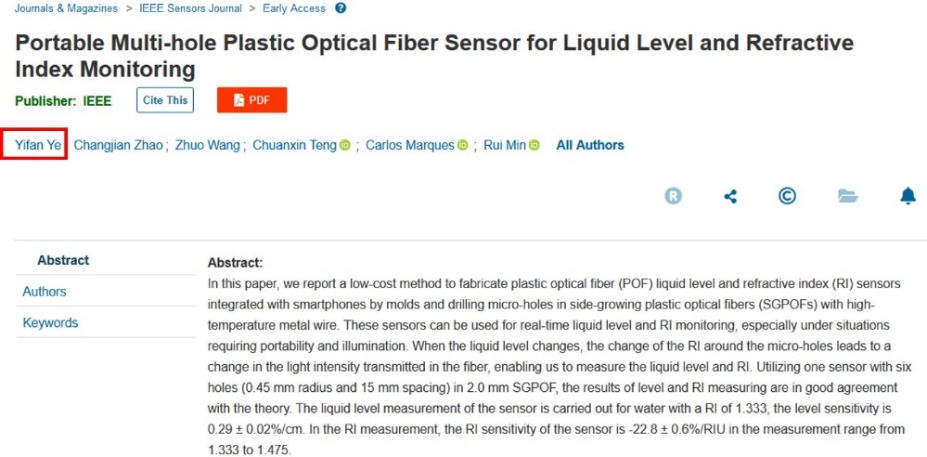Yifan Ye, a BNU (Beijing Normal University) undergraduate of 2019 majoring in physics, conducted an extended research with his teammates on the liquid level and refractive index monitoring integrated with smartphones under the guidance of Dr. Rui Min from the Advanced Institute of Natural Sciences. And the article with the reserach results entitled “Portable Multi-hole Plastic Optical Fiber Sensor for Liquid Level and Refractive Index Monitoring” was published in IEEE Sensors Journal . The research also gained support from the key project "Development of Flexible Optical Fiber Wearable Cardiorespiratory Monitor with Smart Phone Pixel Perception"of the Guangdong Province “Climbing Program” Special Funds.

Fig. 1. A screen shot of the online abstract page (Linked: https://ieeexplore.ieee.org/document/9985991/)
Liquid level and refractive index measurements are widely used in fuel storage and transportation, leakage monitoring of chemical products and industrial production and sewage treatment, etc. Compared with other technologies, fiber optic sensors have the advantages of small size, no electromagnetic interference, corrosion resistance, and fast response. Fiber optic sensors could also provide a safe measurement solution for extreme environments. To date, different liquid level measurements based on fiber optic sensors have been proposed, but most of these sensors adopt wavelength modulation and require expensive sensing systems. In addition, these sensors usually require complex manufacturing processes and high demands for the light source in measurements. In the proposed research, Ye et al. fabricate the sensor by drilling micro-holes in MMA side-growing plastic optical fibers with high-temperature metal wire without large drilling machines or expensive lasers and integrate the sensor with a smartphone to simplify the equipment requirement.
In this study, Ye et al. proposed a method of fabricating a multi-hole plastic optical fiber sensor for liquid level and refractive index sensing, and the smartphone was used as the input and reception device to achieve portability and fast analysis (shown in Fig.2). When the liquid level changes, the change of the refractive index around the micro-holes leads to a change in the light intensity transmitted in the fiber, enabling the measurement of the liquid level and refractive index. This kind of plastic optical fiber sensor performed well in liquid level and refractive index measurement. Compared with other existing works, the sensor presented here is easier to fabricate and assemble at a low cost with portability and illuminating ability, providing a new idea for the exploration of other similar monitoring equipment, which has important scientific significance and practical application value.

Fig. 2. The schematic diagram of the liquid and refractive index measuring system


